Author: Rachel Brown Via: https://diygarden.co.uk/growing/how-to-grow-wine-grapes/
Although wine can be made from any type of grape, wine grapes are in a class of their own if you’re looking to produce a rich and complex wine. They’re smaller, full of seeds, and have thicker skins, and while they may not be as tasty as table grapes when eaten fresh, they also have a higher sugar and juice content, making them ideal for turning into wine.
Growing Wine Grapes: A Quick Snapshot
When to Sow – Feb-Apr
When to Plant – Apr-Jun
When to Harvest – Aug-Oct
Average Yield per Plant – 0.5kg/year
Spacing – 90-180cm
Depth – 30cm
How to Grow Wine Grapes at Home
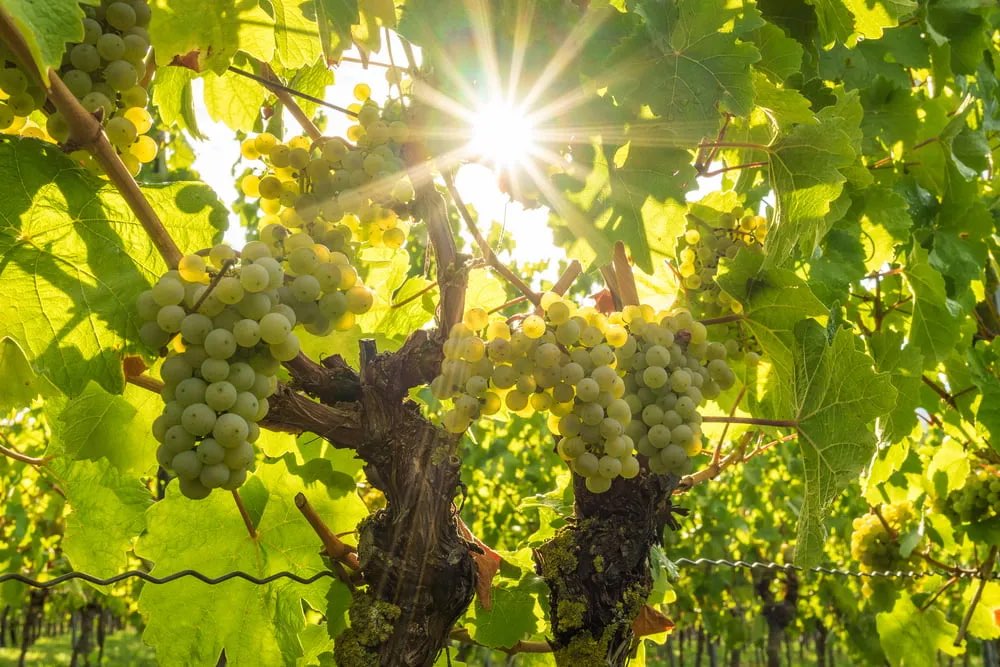
While grapevines may be a common garden feature in the warmer parts of the world, those who live in cooler regions often don’t even consider the possibility of growing their own grapes. After all, don’t you need plenty of sun and heat?
It’s true that some of the more traditional varieties would struggle in temperate climates, but grapes have come a long way since they were first cultivated back in 6500 B.C. Today, you’ll find over 10,000 varieties of wine grapes alone – pick one that perfectly matches the growing conditions that you can offer and you could be sipping on some homemade wine sooner than you expected!
How Much Sun Do Wine Grapes Need?
Many of the more traditional wine grape varieties need full sun, but there are now also several that will tolerate partial shade too. Morning sun is most important when growing grapes – some afternoon shade won’t affect your yields too much, especially if you choose a variety that’s accustomed to this.
In order to maximise sun and heat, many gardeners position their grapevines along a sunny wall or fence. The sun and the heat that’s absorbed by the wall will then be reflected back onto the vines, creating a cosy microclimate.
Getting Your Soil Right
When it comes to growing wine grapes, soil is extremely important. Although grapevines will tolerate just about any soil type, apart from overly wet, your soil will heavily influence the characteristics and flavour of your finished wine. Some of the best soil types for growing wine grapes are:
- Loam – many would say that a loamy soil is the best way to go – it’s well-draining but still offers the perfect balance of nutrients and water
- Sandy – in colder regions, sandy soil produces a highly aromatic wine. However, in warmer climates, sandy soil should be avoided – it will dry out too quickly, resulting in a wine that’s lacking in colour, acidity, and tannins
- Clay – some of the boldest and punchiest wines in the world have been grown in clay soil, which is fantastic for moisture retention and keeping roots cool
Choosing the right grape varieties for your soil type is key. However, whichever you choose, your soil will still need to be well-draining and deep.
Other Wine Grape Growing Requirements to Consider
Experts often prefer planting grapevines on a slope. This helps to encourage good drainage, while preventing the soil from becoming waterlogged.
Either way, whether you plant on a slope or on flat ground, keep in mind that your grapevines will need supports. Trellis systemsare the easiest way to provide this, but have this set up before you get planting.
How to Grow Wine Grapes from Seed
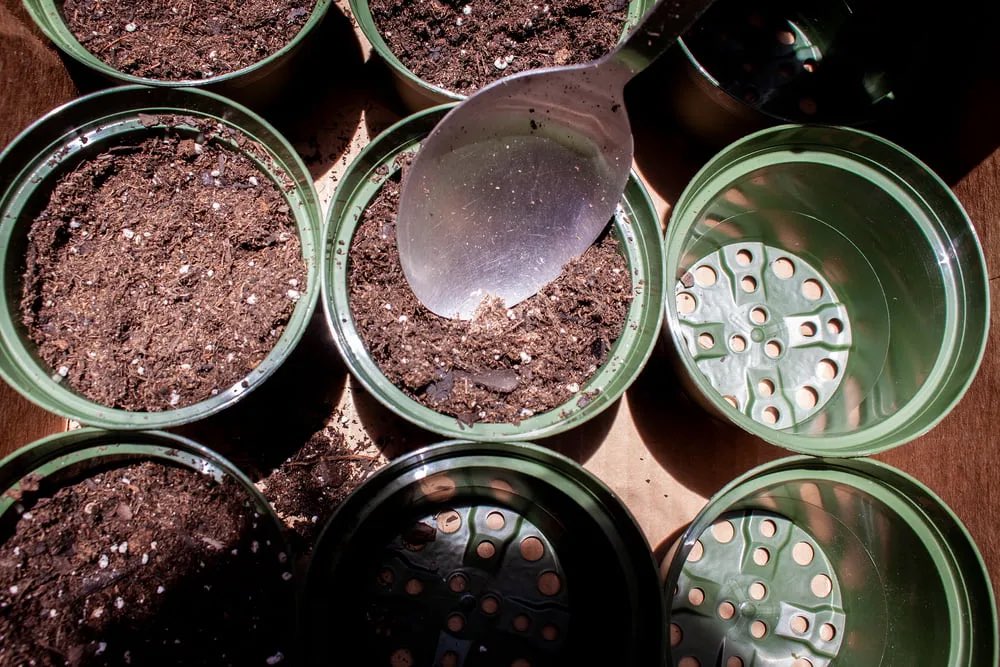
Although it’s technically possible to grow wine grapes from seed, this isn’t commonly done. Grapes grown from seed aren’t true to type, meaning that they probably won’t turn out to be the same variety as the parent plant that produced those seeds. Since wine grapes contain specific acidity, sugar, and juice levels, grapes grown from seed may not offer the same, meaning that they won’t produce a tasty wine.
What makes this even worse is the fact that it can take a few years before your seed-grown grapes are ready to be harvested. This means that you’ll be spending a significant amount of time cultivating your precious vines, only to find out that the fruit isn’t suitable for what you need.
If you would still like to try growing wine grapes from seed, your seeds will need to be cold stratified for two to three months first. Skipping this step will result in very poor germination rates, since grape seeds are covered with a tough outer coating that can keep the seeds dormant for years. Start the stratification process towards the end of the year, so that you’re ready to get sowing in early spring.
How to Sow Wine Grape Seeds:
- Fill small pots with a multipurpose compost
- Water your pots well, making sure that excess water is able to drain out. Remember that grapes hate to be waterlogged!
- Sow one grape seed into each pot, a couple of cm deep
- Water lightly again to settle the seeds into place
- Place your pots somewhere warm – grape seeds need temperatures of around 21°C during the day and 15°C at night in order to germinate
It can take anywhere between two weeks to two months for your grape seeds to sprout. Once they do, make sure that they’re getting plenty of sun. You will also likely need to repot them once before they’re ready to be planted out.
How to Grow Wine Grapes from Cuttings
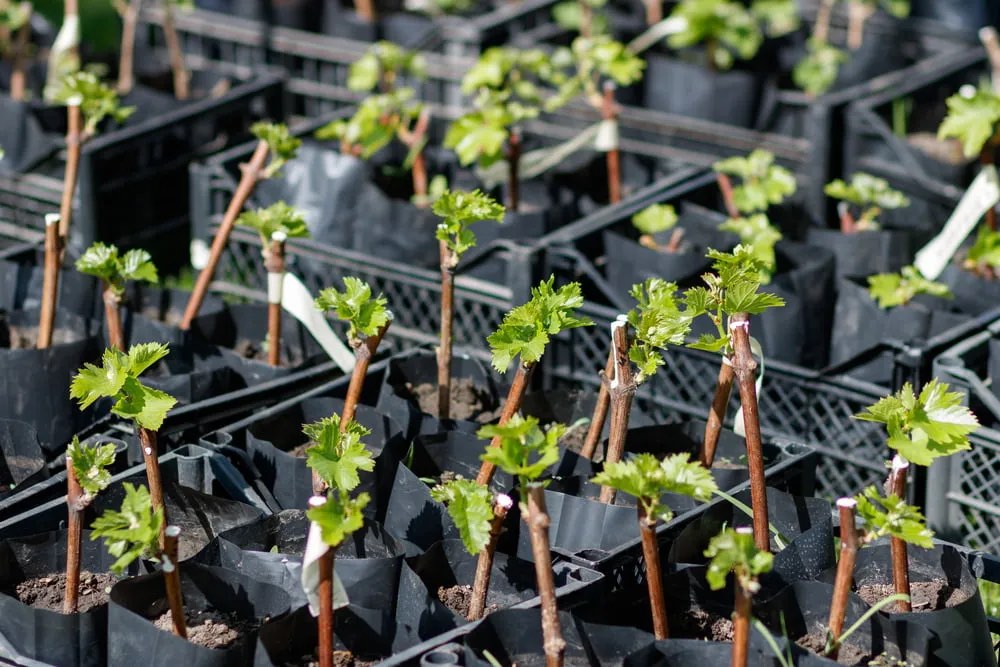
Cuttings are the most common way to propagate grapevines. These should be taken in late winter from mature growth. Look for 30cm-long canes that have hardened off at the end, without any green showing.
Ideally, each cutting you take should also have at least three buds. While shorter, single-bud cuttings can still be propagated, success rates are much higher with more buds and longer cuttings.
How to Take Grapevine Cuttings:
- Cut your chosen canes off the vine. Snip the top so that it’s quite flat, but cut the bottom at an angle. This will help to identify both ends, saving you from planting them upside down (which will prevent them from rooting)
- If you’ve got some rooting hormone powder, dip the bottom of each cutting into this. You can also make your own rooting hormone from items that you may have around the house, such as honey, cinnamon powder, and aloe vera
- Fill some pots with a multipurpose compost
- Push a cutting into each pot, deep enough so that just the top two buds are above the surface of the soil
- Keep the soil very lightly moist and place them in an area that receives morning sun but afternoon shade (too much heat will dry them out)
- Once you notice new leaves growing from your cuttings, they should then be moved into a larger container. While you could plant them straight out instead, experts recommend growing cuttings on in pots for a year before planting. This helps them to establish a strong root system, and they’ll then be ready for planting the following spring
How to Plant Wine Grapes Outside
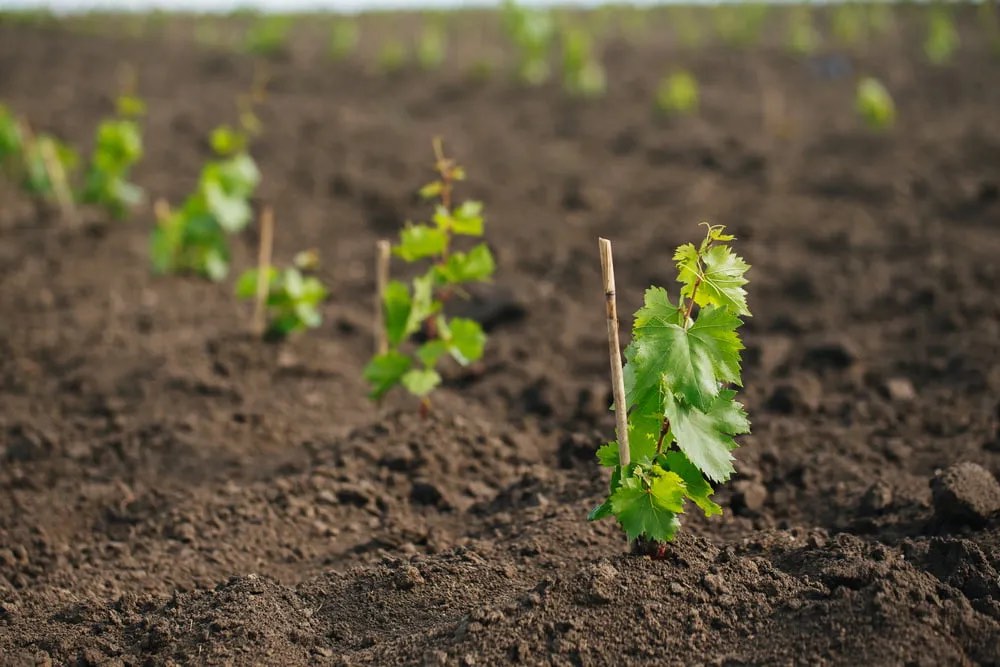
Grapevines are best planted out when they’re still dormant, meaning early in the spring. Even if you live in a cold region that experiences hard freezes over the winter, you can still grow your grapes outside, so long as you pick a suitable variety.
Prepare your planting area by thoroughly weeding it, ensuring that the soil is good quality, and setting up your trellis system. Then, dig holes that are large enough to accommodate the root balls of your plants. Spacing depends on variety, so check what’s recommended for yours – it could be anywhere between 90cm-180cm.
Place your plants into the holes so that the top of the root ball is level with the surface of the soil. If you’re planting against a wall,leave at least 20cm of space between the root ball and the wall. Cover the roots over with soil and firm down, before topping up with a little more loose soil. Water well after planting.
How to Plant Wine Grapes in a Greenhouse
Although your grapevines will likely do just fine outside (so long as you’ve picked a suitable variety!), growing them in a greenhousehas a couple of distinct advantages. Firstly, it will give you access to a greater choice of varieties, since they’ll have a warmer and more protected growing environment. This also means that yields tend to be higher and the fruit is usually of a better quality.
The main downside to growing wine grapes in a greenhouse is the amount of space that they need. Grapevines grow pretty large, and while you can train them to grow up the side of your greenhouse, they will still take up a significant amount of that precious growing area.
When it comes to growing wine grapes in a greenhouse, you have two main options; plant the roots just outside your greenhouse, creating a small hole for the vines to grow in, or plant the roots inside. The outside method gives the roots a natural supply of moisture and nutrients, while indoor roots will require more care and attention.
Dwarf wine grape varieties can also be planted into containers. However, this does limit root growth and spread, so go for a container that’s as large as possible, ensuring that it offers good drainage.
How to Care for Wine Grapes
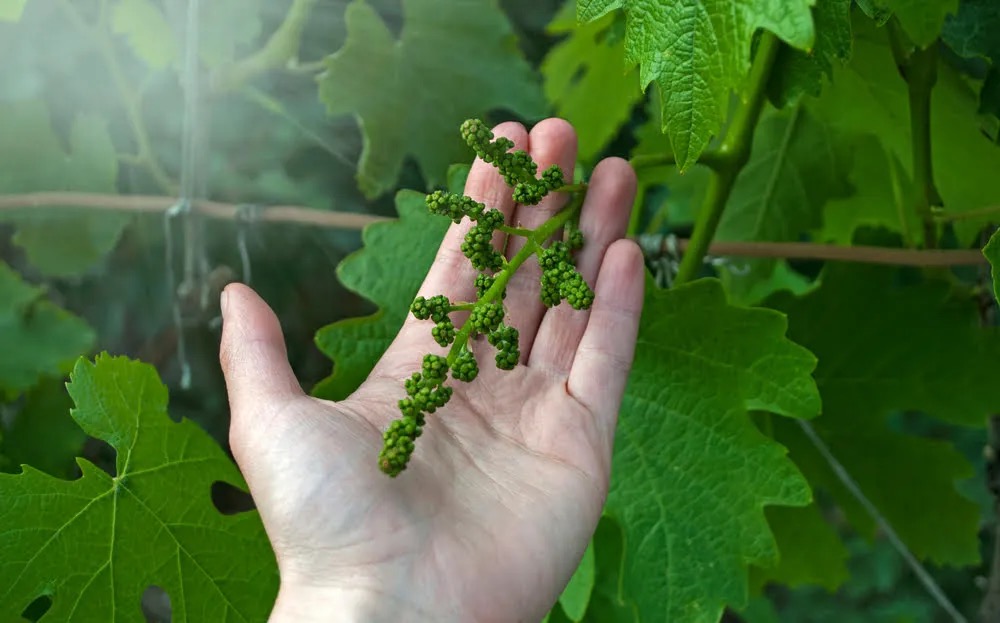
In order to produce good yields, your wine grapes will need regular care throughout the growing season. Here’s what you need to do:
Watering Wine Grapes
Your grapevines will need about 2.5cm of water a week. This needs to be consistent and regular – don’t allow the soil to dry out, especially in the first two years after planting. After this, your plants will become much more drought-tolerant and will only need to be watered during long dry spells.
When you water your wine grapes, make sure that you’re thoroughly saturating the root zone. Try to prevent water from splashing up onto the leaves as much as possible – this can lead to diseases developing.
Feeding Wine Grapes
Wine grapes don’t usually need to be fed much, especially if your soil was already of a good quality. An application of fresh compost around your plants each spring should give them everything that they need.
However, if your grapevines aren’t growing as fast as they should, or are looking weak in any way, a springtime application of a balanced, multi-purpose fertiliser should give them what they need.
Weeding Grapevines
While mulching is usually recommended as a way to suppress weeds, grapevines are a little different. A mulch often keeps soil temperatures cool in the spring and summer, but wine grapes need their soil to be warm at this time of year in order to really take off.
This means that you’ll need to manually weed around your grapevines instead. Do this regularly throughout the growing season, as too many weeds will inhibit growth, therefore affecting yields.
Training Grapevines
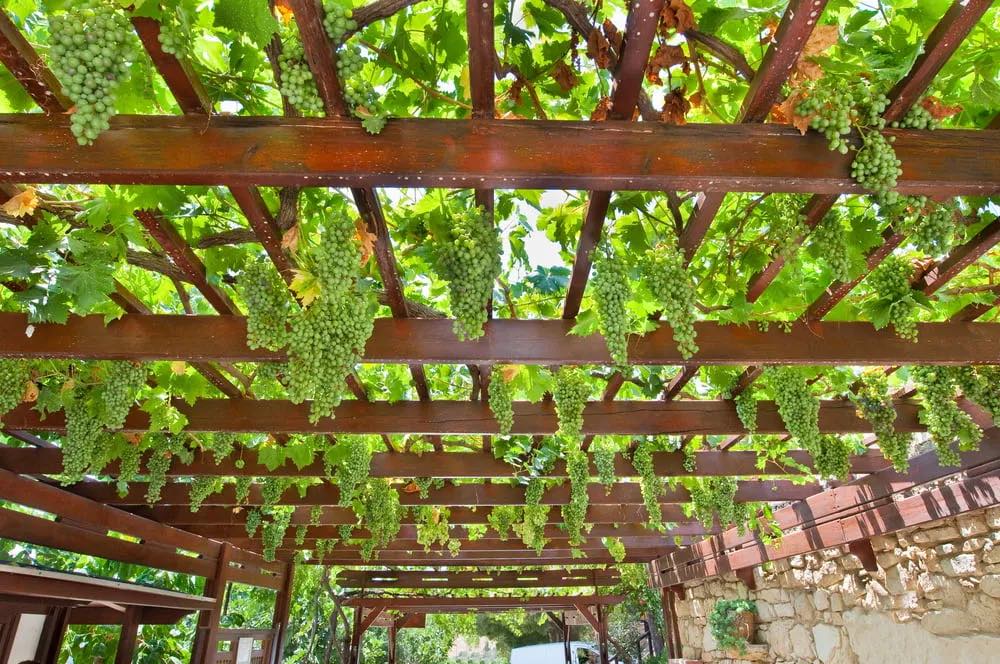
As your grapevines grow, they’ll need to be trained up your trellis system. This only needs to be done at the beginning – once they’ve taken hold, they’ll pull themselves up.
There are several methods out there for training grapevines, making it worth doing some extra research into this. You can keep things simple by running strings of wire along either side of your grapevines to keep them straight, or you could get a little more complex and train your vines into fans or cordons. Grapevines are extremely ornamental and, with a little creativity, can be trained to beautifully decorate a garden.
Pollinating Wine Grapes
When grown outside, wine grape flowers are naturally pollinated by insects and the wind. However, if your grapevines are in a greenhouse, pollination could suffer. This makes hand pollination essential.
Don’t worry, the process is easy – once you see that several flowers have blossomed, simply give the vine a gentle shake to mimic the wind. Alternatively, dab a small paintbrush into the centre of each flower – as you move from flower to flower, the brush will pick up and drop pollen.
Pruning Wine Grapes
Grapevines need to be pruned quite heavily once a year. If you skip this step, your yields will suffer and your plants will also struggle to thrive.
Pruning is best done late in the winter or early in the spring. Usually, all but one or two trunks from each plant are cut away. The side cordons should be pruned too, leaving just 2-4 per plant. This may seem harsh, but pruning away 80-90% of new growth will ensure a heavy crop.
How to Harvest Wine Grapes
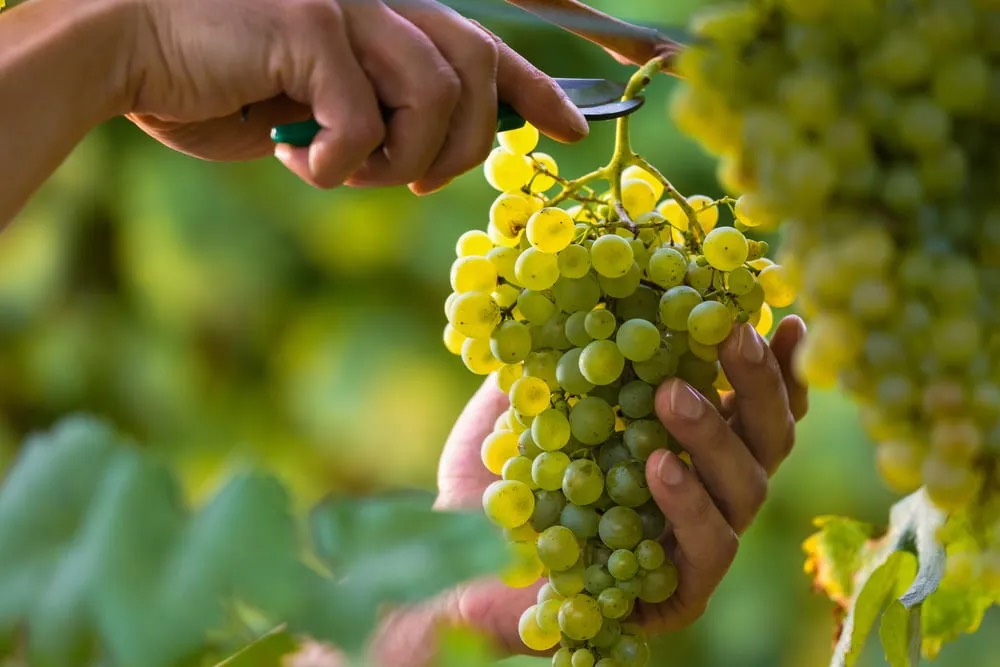
Wine grapes stop ripening once they’ve been picked, so you need to make sure that they’re at the perfect stage of ripeness before harvesting them. They may change colour before this, making it important to sample a few grapes before harvesting the rest. A ripe grape will have a good flavour balance of sweet and tart. They’ll also be plump, juicy, and easily crushed.
If your grapes are struggling to ripen and you’re nearing the end of the season, cut back some of the foliage around the fruits. This will allow more sunlight in, speeding up the ripening process.
To harvest your grapes, use your pruning shears to clip full clusters off from the vine. Be gentle with them – ripe grapes will bruise and burst easily. Then, remove any discoloured or damaged grapes before placing them into a cooler or a room with fans.
It’s often recommended that wine grapes should be harvested at night. The cooler temperatures help to preserve acidity while keeping sugar levels stable, resulting in a better-tasting wine.
How to Store Wine Grapes
If you plan on making wine, then it’s best to do this with grapes that are as fresh as possible.
However, wine grapes do still store well. They can be kept in a fridge for a couple of weeks, or in a root cellar for up to six weeks. Place them into a cardboard box that’s lined with clean straw, and use more straw to separate each cluster, so that they’re not all touching each other. Since grapes easily absorb smells, keep them well away from any other fruits and vegetables.
How to Prepare & Cook Wine Grapes
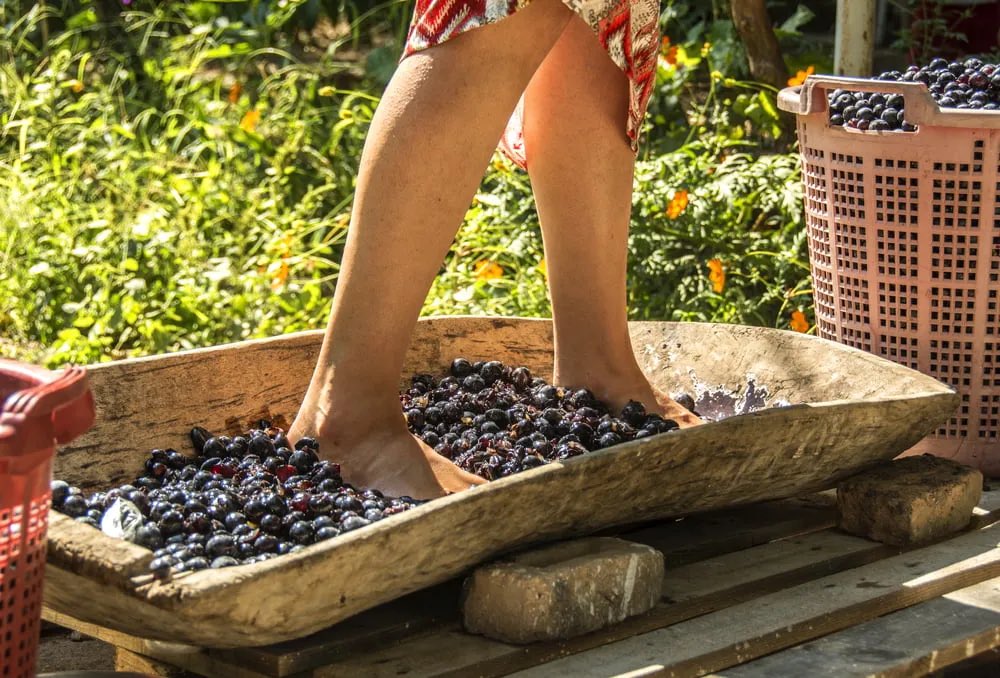
Chances are, if you’re growing wine grapes, then you’re hoping to make some homemade wine. 1kg of grapes usually amounts to 1 litre of liquid, so weighing your harvest will give you a good idea of how much wine you can make.
The winemaking process isn’t simple and will require some in-depth research. However, the basic steps are as follows:
- Crush and press your grapes
- Check sugar and acidity levels
- Add in a wine yeast and leave to ferment
- Strain the liquid and then continue fermenting
- Siphon your wine into a clean bucket and leave to clear
The fermentation process usually takes about 2-6 weeks. It varies based on the sugar content of your grapes, as well as the temperature that you’re fermenting at. Once fermented, your wine will need to be left to mature for a few months.
In addition to making wine, you can also use your wine grapes to make everything from grape juice to jams, jellies, sodas, and raisins. Although wine grape varieties aren’t the best for eating fresh, they’re incredibly versatile in the kitchen.
Common Wine Grape Problems
Most of the problems that gardeners experience when growing wine grapes can be easily avoided by ensuring good air circulation. However, even then, some of the most commonly encountered issues are:
- Birds – birds love feasting on ripening grapes and will quickly clear your grapevines before you’ve had the chance to harvest them. The only way to prevent this is by netting your plants. Once you’ve taken all you need, you can then remove the netting and leave the rest of the grapes for the birds
- Powdery mildew – this disease manifests as a white powdery substance on the leaves and fruit, and seriously inhibits growth. A potassium bicarbonate spray is a great way to kill off the spores and treat the disease, without harming your plants
- Small fruit clusters – this is usually down to a lack of pollination. However, deficiencies in nitrogen, boron, and zinc can also result in this, making it worth having your soil tested if you know that there weren’t any pollination issues
- Fruit rot – there are many types of rot diseases out there that thrive in crowded and humid conditions. You’ll need to immediately remove any affected plant parts and then look for a treatment spray that targets the exact type of rot you’re dealing with
Popular Wine Grape Varieties to Grow
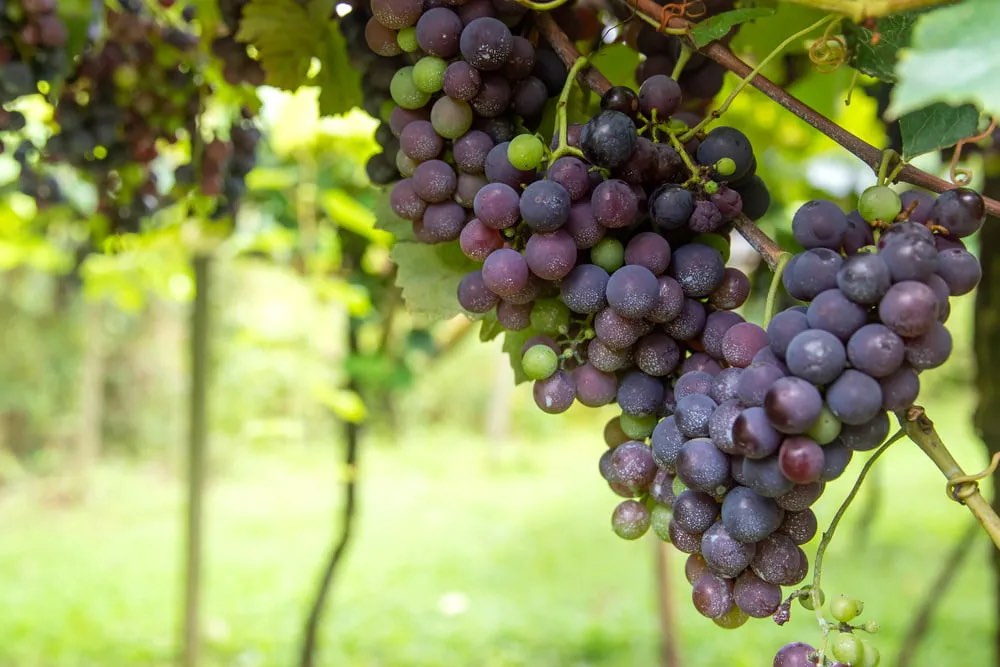
The importance of choosing the right wine grape varieties for your growing conditions has been emphasised several times now. No matter where you live, you’ll be able to grow wine grapes, but only if you pick suitable varieties for your climate.
If you live in a warmer region, then you’ll have more choices when it comes to varieties. You’ll also be able to try growing seedless wine grapes, which need the heat in order to thrive. However, for those of you in cooler climates, some of the best varieties to consider are:
- Frontenac Gris – produces small pink grapes that are perfect for making sweet white wines
- Marquette – a black/blue grape that’s related to the Pinot Noir and is used for making red wine
- Swenson White – juicy yellow/green grapes that can be made into wine as well as eaten fresh
- LaCrescent – these grapes have a distinct fruity/honey-like fragrance, resulting in a very complex wine
- Bacchus – often referred to as the English Sauvignon Blanc because it produces a very refreshing and fruity white wine
Conclusion
Thanks to all of the new wine grape varieties out there, homemade wine now has the potential to taste just as good as wines that have been professionally crafted. Although wine grapes do require more work than most of the other fruits you’ll grow in your garden, the satisfaction that you’ll experience once you’re sampling your bottles of homemade wine will make all of that effort more than worth it!
